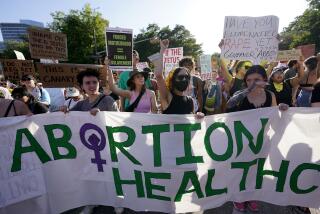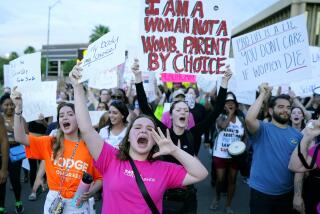Abortion rate in the U.S. falls to a 46-year low, data show
The abortion rate in the United States hit a 46-year low in 2017, a drop experienced in both conservative-led states that have restricted the procedure and liberal-led states that have expanded access, according to a report released Wednesday by a research group that supports abortion rights.
The nationwide rate dropped to 13.5 abortions per 1,000 girls and women ages 15 through 44 in 2017, from 16.9 abortions per 1,000 women in 2011, a decline of 20%, according to data analyzed by the Guttmacher Institute, which conducts a survey of abortion providers that is widely used by both sides of the debate. It continues a decades-long trend in declining abortion rates.
The number of abortions fell by 19% to 862,000 between 2011 and 2017.
The drop comes amid a declining pregnancy rate, greater access to contraception and a significant increase in restrictions on abortion in conservative-led states.
The abortion rate fell dramatically in several states that enacted strong antiabortion legislation in recent years, suggesting that some of the antiabortion movement’s efforts in state legislatures are limiting access.
Four states that enacted laws requiring clinics to have building and safety standards comparable to hospitals experienced some of the most significant declines in their abortion rate. Between 2011 and 2017, the abortion rate fell by 27% in Arizona and Ohio, by 30% in Texas and by 42% in Virginia. The number of clinics that provide abortion similarly fell in those states.
While the Supreme Court ruled in 2016 that those requirements were illegal, the laws still led to the closure of clinics that did not reopen.
Opponents of abortion are likely to hail the drop in the overall number of abortions in the United States and the effect of the laws. But Guttmacher’s chief executive and president, Dr. Herminia Palacio, said the focus should not be on the rate.
“Lowering the abortion rate is not the goal here. The abortion rate is just a number,” she said. “Policy should focus on patients’ health and rights, regardless of how it might affect the abortion rate.”
The fact that the abortion rate declined nationwide, regardless of a state’s political leanings and how many abortion clinics it had, suggested that several other factors are at play, according to Guttmacher. Only five states and the District of Columbia reported increases in their abortion rates.
“Fifty-eight percent of the decline in the number of abortions nationwide happened in the 18 states and D.C. that did not enact any new restrictions,” said Elizabeth Nash, senior state policy manager at Guttmacher. “There is no clear pattern linking these declines to new restrictions.”
California, for instance, has actively tried to expand access to abortion. Democratic Gov. Gavin Newsom earlier this year signed a proclamation “welcoming women to California” and hailed their opportunity to “exercise their reproductive rights.”
The number of abortion clinics in the state has remained steady at about 161 facilities between 2011 and 2017. But the abortion rate over that time fell by 29%, from 23 abortions per 1,000 women to 16.4.
Researchers pointed to several causes, including greater access to contraception as required under the Affordable Care Act and a possible decline in sexual activity.
They also speculated that more women may be accessing abortion medication outside traditional clinics or healthcare provider settings, such as by purchasing online. Those patients would not be included in these figures.
The pregnancy and birth rates nationwide are also in decline.
The clinic closures reported in Texas, Arizona, Ohio and Virginia underscore a widening gulf between access to abortion providers in conservative parts of the country and more liberal regions.
Over six years, 50 clinics closed in the South, including 25 in Texas alone. Another 25 closed in the Midwest. By comparison, only 7 clinics closed in the West and 59 new facilities opened in the Northeast.
“It’s becoming more polarized,” said Rachel Jones, a principal research specialist at Guttmacher. “Abortion access in the Northeast and the West has typically been less restrictive. States in those parts of the country have typically been more supportive of abortion rights.”
More to Read
Start your day right
Sign up for Essential California for news, features and recommendations from the L.A. Times and beyond in your inbox six days a week.
You may occasionally receive promotional content from the Los Angeles Times.







